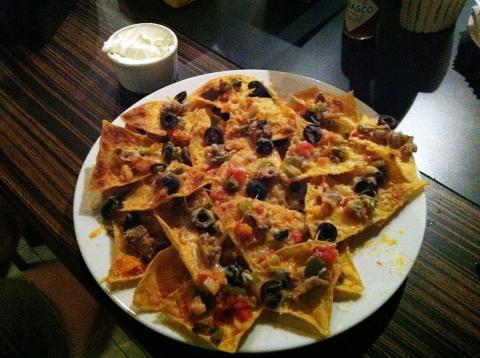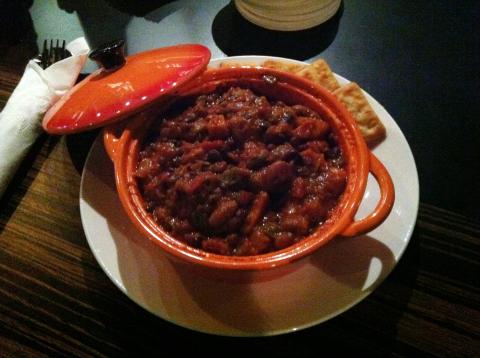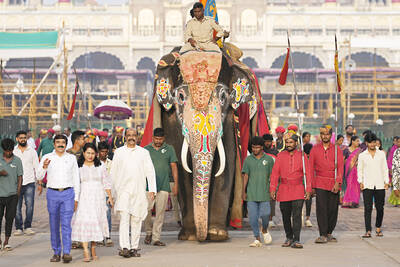The expat community in the Sindian (新店) area has a new spot for reasonably priced, home-cooked meals. The Green Hornet Cafe serves simple Tex-Mex and Western fare, and makes for a nice alternative to the night market food stalls and overpriced restaurants in the Bitan (碧潭) riverside park area.
Named and decorated in honor of the 1960s television show and movie, the Green Hornet Cafe feels more like a neighborhood pub than a cafe, but that’s the way owner Peter Dearman intended it to be.
Dearman, a 41-year-old Canadian expat who came to Taiwan in 1998 and now calls Taipei home, had been yearning for a welcoming place near where he lives at which customers could dine and stay for a beer or two afterward. He opened shop in May.

Photo: David Chen, Taipei Times
The burritos are a favorite among Green Hornet habitues. The regular option (NT$120, comes in a set of two) is filled with refried beans made from scratch, salsa, jalapenos, cheese and sour cream. Have them with beef or chicken for NT$140, or replace the refried beans with chili for NT$130.
Another popular item is the nachos, which Dearman says are a house specialty. The regular version (NT$120) comes with salsa, Monterey Jack and Cheddar cheese, refried beans, jalepenos and black olives, all mixed together nicely in several layers of tortilla chips. The nachos nearly ruin your appetite for dinner — they were so tasty that my friend and I gobbled them up quickly.
You won’t find burgers and fries at the Green Hornet, a conscious decision on the part of Dearman, who says his motto for the restaurant is “No grease, no BS.” By the latter, Dearman means no fancy names and not too many obscure ingredients, just plain meals that are nourishing, relatively healthy and easy to prepare.

Photo: David Chen, Taipei Times
I liked the vegan chili (NT$140), which is probably one of the menu’s more exotic items. It won’t take top prize in any chili cook-offs, but it still offers plenty of homemade goodness. Ingredients include fresh kidney, pinto and black beans (the Asian soybean variety), lentils and quinoa, all stewed in a garlic and onion tomato base. Chili is also available with beef for NT$160, and expect both types to be spicy unless you request otherwise. Rice can be ordered for an additional NT$20.
Carnivores will likely enjoy the 10oz-cut of New York steak for NT$400 or the 12oz rib eye sirloin for NT$380, which both come with a side of vegetables and mashed potato. Dearman recommends the steamed mussel soup (NT$150), one of his favorite comfort foods from his childhood in Nova Scotia.
With all of the framed photos of Bruce Lee (李小龍) as Kato hanging on the walls (hunt around for the one Jay Chou (周杰倫) poster), customers could guess that Dearman is an obsessive fan of the Green Hornet.
He isn’t. He chose the name because it was “easy to remember,” and he felt that Lee was a “fitting” cross-cultural symbol for a restaurant serving Western food in Asia.
The Green Hornet is still a work in progress. Dearman plans to expand the menu, and eventually extend his business hours beyond dinner, with an eye on serving a Sunday brunch.
There is no waitstaff at the moment and Dearman does all the cooking, so patience might be in order if the place is full. That’s all the more reason to take advantage of the free WiFi and have a cold beer. A pint of Guinness is NT$180 and San Miguel is NT$130, or try to beat the heat with a bottle of Hunter’s Cider (NT$150) or Savanna (NT$170), both South African brews.

A jumbo operation is moving 20 elephants across the breadth of India to the mammoth private zoo set up by the son of Asia’s richest man, adjoining a sprawling oil refinery. The elephants have been “freed from the exploitative logging industry,” according to the Vantara Animal Rescue Centre, run by Anant Ambani, son of the billionaire head of Reliance Industries Mukesh Ambani, a close ally of Prime Minister Narendra Modi. The sheer scale of the self-declared “world’s biggest wild animal rescue center” has raised eyebrows — including more than 50 bears, 160 tigers, 200 lions, 250 leopards and 900 crocodiles, according to

They were four years old, 15 or only seven months when they were sent to Auschwitz-Birkenau, Bergen-Belsen, Buchenwald and Ravensbruck. Some were born there. Somehow they survived, began their lives again and had children, grandchildren and even great grandchildren themselves. Now in the evening of their lives, some 40 survivors of the Nazi camps tell their story as the world marks the 80th anniversary of the liberation of Auschwitz-Birkenau, the most notorious of the death camps. In 15 countries, from Israel to Poland, Russia to Argentina, Canada to South Africa, they spoke of victory over absolute evil. Some spoke publicly for the first